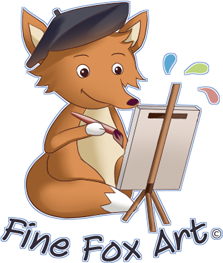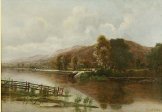On the Derwent
| Artist | : | Ernest Parton |
| Medium | : | Oil |
| Size unframed | : | 42"/29" |
| Size framed | : | N/A |
| Signature Info | : | Hand Signed - By the artist |
| Frame Info | : | Not Framed |
| Condition | : | Excellent |
| Year | : | Unknown |
Description
This is a beautiful, large Original Oil on Canvas by ERNEST PARTON (1845-1933) ''On the Derwent, - River Landscape with Figures in a Punt and Cattle,'', signed, bottom right. Also signed and inscribed, verso, size 29'' x 42'' (74cms x 107cms)
-
Artist: Ernest Parton
-
Title: "On the Derwent"
-
Medium: Original Oil on Canvas
-
Year: Unknown
-
Edition: Unique, original work
-
Size: 29 in x 42 in
-
Signature: Hand signed by artist
Ernest Parton
(1845 - 1933, USA)
Ernest Parton, born at Hudson on March 17,1845, was his brother Arthur's closest friend; it is not surprisingly he followed in Arthur's footsteps.
His journal entries for 1864 intersperse sketching notes with observations on the dramatic concluding days of the Civil War, During a three-day tour of the Catskills with Arthur he " made several sketches each day." A few days later: "Mt. Merino.... Not good." The next day: "sketches in oil." The following day: "sketches of effect of light and shadow... Effect magnificent! " Ernest's journal reflects his decision to reject formal training-on Arthur's advice-and paints from nature.
He joined his older brother at his Broadway studio in 1865 at the age of twenty. It was here and during summer sketching trips with Arthur that Ernest received his training. What he learned can he judged from an oil sketch inscribed E l’ 1865 that appears to be a view of the Hudson River at Mount Merino and reflects the Hudson River School style.
By the spring of 1873 Ernest felt sufficiently competent to sail for England as his brother had four years earlier. A letter from Arthur written June 4, 1873 notes that he can imagine Ernest's disappointment at the "cold, rainy weather in Scotland but that "some of the finest things [are the] effects when those showers clear away, especially on the lochs." It can be assumed that Ernest undertook this journey not merely in emulation of Arthur but because Arthur's paintings of the English lakes and the Scottish lochs were winning praise and commercial success.
He apparently decided to stay in England because the art market was better there. Ernest seems to have achieved some recognition fairly quickly. He rented a London studio on Newman Street and exhibited two paintings at the Royal Academy in 1875. In 1877, Ernest seems to have decided to study Barbizon painting directly. Dated drawings of Lake Como and Lucerne document a trip to the Continent in the summer of 1876.
At some point, he met up with a group of American artists, among them Theodore Robinson, John Singer Sargent, Daniel Ridgeway Knight, and Henry Bacon. Ernest's use of muted light and its reflection on smooth water was very much in the style of Corot and Daubigny. He also used similar subject matter-silent rivers, stone bridges, and graceful trees conveying the spiritual refreshment of the un-industrialized countryside. Streatley-on- Thames, similarly shows his reflected light and the serenity' of the river.
On April 30, 1879, Ernest wrote to his mother: "I sent my picture [The Waning of the Year] as usual to the Royal Academy and was surprised to receive a letter from them… asking me the price of it.... It was a large picture. ... so I put on less than I would otherwise would.... You can imagine my surprise on going to the Academy on Varnishing Day (Opening Day) to find my picture... in a place of honour, in fact the very best place in the Royal Academy-the center of the room.”
Ernest was quick to capitalize on the popularity' of “The Waning of the Year.” He had L. Solomy make an etching of it, and he produced many landscapes in a similar style, such as “Burnham Beeches” and “Birch Trees and Stream.” Ernest exhibited annually at the Royal Academy through 1932 and at other venues in England, Scotland, Ireland, New York City, and Springfield, Massachusetts.
His work, which lacks Arthur's stylistic range, was of consistently high quality'. Ernest found an eager and steady market and continued to paint until his death. Ernest Parton died in New York on September 15, 1933. He had remained in England until 1932 and continued through 1931 to exhibit the Barbizon-style paintings that had brought him success. A 1910 article by Austin Chester in Windsor Magazine praised him as a student of the theory of light, who "had succeeded in apprehending and showing the abstract beauty of Nature as a result of his contact with the Barbizon painters, who had taught him to paint its essentials.


